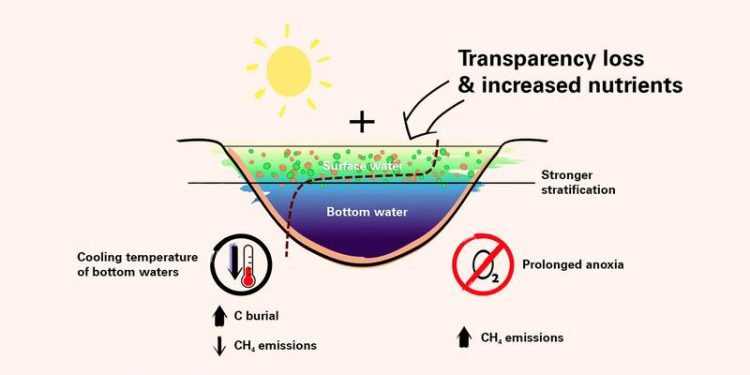Warm on top, cold below: unexpected greenhouse gas effect in lakes

Effects of climate change on the water temperature, water transparency, density stratification and oxygen content in lakes. University of Basel
Lakes play an important role in the global carbon cycle, acting as large natural bioreactors. The temperature of a lake represents an important constraint on the amount of carbon dioxide and methane it emits into the atmosphere.
It was generally assumed that global warming stimulates microbial respiratory processes and the production of these greenhouse gases, while at the same time reducing the carbon storage in lake sediments. An international research team has now examined these interactions more closely and discovered unexpected effects.
The research project not only targeted the direct effects of global warming, but also the indirect ones. The main focus of the investigations was the water temperature and greenhouse gas production in the deeper parts of the lakes.
“We don’t want to question the fundamentals of thermodynamics. There is no doubt that the rates of respiratory metabolic processes in lakes are generally higher at increased water temperatures,” explains Professor Moritz Lehmann from the Department of Environmental Sciences at the University of Basel. “However, climate change will not cause every lake to warm up everywhere.”
Warming near the surface, cooling near the bottom
Lakes worldwide are warming at the surface. However, they are also losing transparency due to increased algae production and enhanced turbidity of the lake water.
“The surface-water warming and the loss of transparency have the effect that more heat is trapped in the upper layers of the lakes, leaving the deeper waters thermally isolated,” says lead author Dr. Maciej Bartosiewicz from the Department of Environmental Sciences at the University of Basel. “Under some circumstances, this can even lead to the cooling of water masses near the bottom of the lake.”
The subtle cooling slows down respiratory decay processes and carbon dioxide production in the lakes, increasing carbon burial within the sediments. Model simulations suggest that the observed effects are most pertinent to relatively small and shallow lakes, which make up approximately half of the global lake surface.
Less carbon dioxide, more methane
The increased differential warming in lakes has yet another effect: the pronounced thermal stratification entails that the deeper water layers do barely mix and are poorly ventilated, which can lead to prolonged anoxia. Under these oxygen-free conditions, methane production by anaerobic microorganisms is enhanced.
“All in all, global warming increases the greenhouse gas potential of lakes, as expected. However, this has less to do with the warming directly, and more to do with increased oxygen depletion at the bottom of these lakes,” concludes Bartosiewicz.
The study was conducted in collaboration with the Université de Montreal and the Eau Terre Environnement Research Centre at the Institut National de la Recherche Scientifique in Quebec.
Prof. Dr. Moritz Lehmann, Dr. Maciej Bartosiewicz, University of Basel, Department of Environmental Sciences, phone +41 61 207 36 16, email: moritz.lehmann@unibas.ch
Bartosiewicz, M., A. Przytulska, J.-F. Lapierre, I. Laurion, M. F. Lehmann and R. Maranger
Hot tops, cold bottoms: Synergistic climate warming and shielding effects increase carbon burial in lakes.
Limnology and Oceanography Letters (2019), doi: 10.1002/lol2.10117
https://aslopubs.onlinelibrary.wiley.com/doi/full/10.1002/lol2.10117
Media Contact
More Information:
http://www.unibas.chAll latest news from the category: Life Sciences and Chemistry
Articles and reports from the Life Sciences and chemistry area deal with applied and basic research into modern biology, chemistry and human medicine.
Valuable information can be found on a range of life sciences fields including bacteriology, biochemistry, bionics, bioinformatics, biophysics, biotechnology, genetics, geobotany, human biology, marine biology, microbiology, molecular biology, cellular biology, zoology, bioinorganic chemistry, microchemistry and environmental chemistry.
Newest articles

A ‘language’ for ML models to predict nanopore properties
A large number of 2D materials like graphene can have nanopores – small holes formed by missing atoms through which foreign substances can pass. The properties of these nanopores dictate many…

Clinically validated, wearable ultrasound patch
… for continuous blood pressure monitoring. A team of researchers at the University of California San Diego has developed a new and improved wearable ultrasound patch for continuous and noninvasive…

A new puzzle piece for string theory research
Dr. Ksenia Fedosova from the Cluster of Excellence Mathematics Münster, along with an international research team, has proven a conjecture in string theory that physicists had proposed regarding certain equations….



